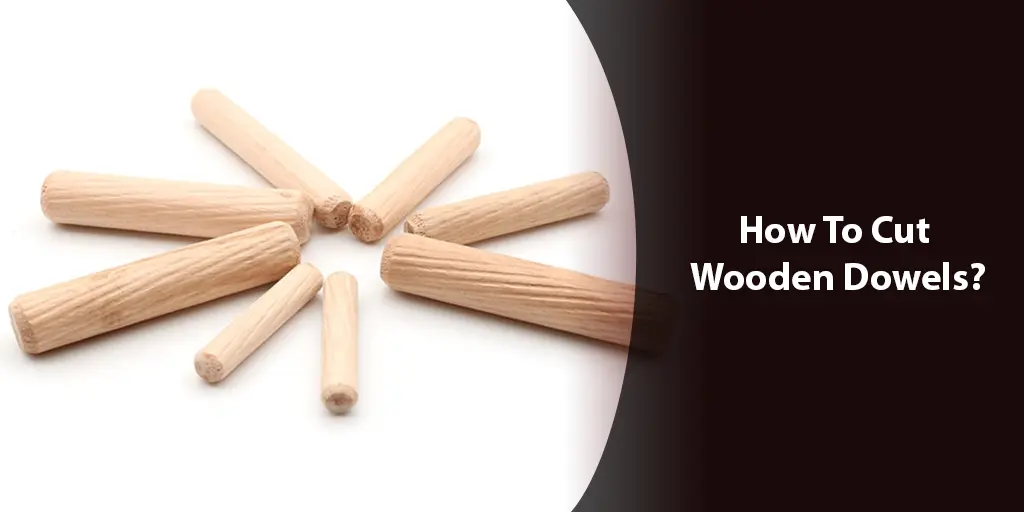Woodworking is a skill practiced by generations of skilled artisans. Whether building furniture, crafting cabinets, or constructing architectural details, wood joins provide enduring strength, stability and beauty.
At the heart of many woodworking techniques are wooden dowels – a simple yet versatile material.

A dowel is a solid cylindrical rod used widely to reinforce joints between wood pieces. In the woodshop and the carpentry trade, dowels feature prominently.
From furniture assembly to repairs, these slender wooden rods fill important structural and aesthetic roles. With a little guidance, even novice woodworkers can gain confidence in dowel techniques.
This article provides a comprehensive overview of cutting wooden dowels, answering questions like: What’s the best way to cut dowels for different projects? How do I ensure clean, accurate cuts? What wood types make the strongest dowels?
We’ll explore methods using table saws, jigs, and hand tools in easy-to-follow steps. Both seasoned pros and beginners can gain new skills and ideas.
For those new to dowels, a quick primer: dowels strengthen joints by resisting wood movement across the grain. When glued into accurately aligned holes, dowels bind materials together.
Their cylindrical shape helps distribute stress evenly compared to other joining methods like nails or screws.
By learning to cut dowels properly, readers can expand their woodworking repertoire. Furniture, cabinets, wooden toys – these projects and more rely on dowels inside. We’ll also address specific techniques like how to cut dowels for delicate projects like cake decorating.
Let’s dive into the various dowel cutting methods, common questions, and tips to feel confident in your skills. Whether you’re a casual hobbyist or serious craftsperson, this comprehensive guide has best practices for success.
METHODS TO CUT WOODEN DOWELS

There are two main approaches to cutting wooden dowels: using power tools like saws or hand tools without power equipment. Each has advantages depending on your skill level, available tools, and project needs. Let’s explore the options in detail.
Cutting With A Saw
This more advanced technique offers speed and precision for cutting multiples dowels quickly. Various saws can be used, each with their own pros and cons:
- Considered the fastest and most accurate option
- Fence guides for straight cuts on dowels of any diameter
- Requires table saw setup and blade height adjustments
- Best for experienced woodworkers
Miter Saw
- Portable for use outside a workshop
- Fence helps keep dowels aligned for clean cuts
- Limited to smaller dowel diameters by blade size
- Requires skills operating sliding blade
Band Saw
- Can cut curves or intricate patterns in dowels
- Smaller blade ideal for tight profiles
- Maintaining precise cut lines takes practice
- Potential for burning or chipping softwood dowels
Cutting Without Power Tools
For novice woodworkers just starting out, consider these low-tech options requiring minimal tools:
Cutting Jig
- Inexpensive to build from scrap wood
- Holes guide steady dowels for uniform cuts
- Slower than saws but no power tool skills needed
- Produces consistent results for long series of dowels
Hand Saw or Knife
- Completely hand tool option using hacksaw or sharp knife
- Very slow process if cutting more than a few dowels
- Requires accurate measuring and careful cutting
- Only suitable for short, small diameter dowels
The table above summarizes key factors to consider when choosing a cutting method for your needs and skill level.
With practice, many aspire to the speed and precision of power tools. But cutting jigs or hand tools remain valid options.
Read Also: Understanding Dowel Joint and Determining the Number of Dowels Per Joint
CUTTING WOODEN DOWELS WITH A SAW
For many woodworkers, a table saw remains the premier tool for consistent, efficient dowel cutting. When set up correctly, it allows repeatable, straight cuts through a long series of dowels. Let’s explore the process in more depth.
Selecting Materials
The first step is acquiring the proper materials:
- Dowel Stock – Hardwood like oak or maple resists splitting and holds their shape under stress. Avoid softwoods.
- Support Wood – A solid piece of scrap serves as your jig board. Pine works, just check for defects.
Setting Up Your Saw Station
To cut accurately:
- Ensure blade protrudes 1⁄4″ above board height for dowel clearance
- Install a zero-clearance throat plate to minimize splintering
- Adjust blade/fence parallelism and secure miter gauge
Making the Cuts
Follow these steps:
- Mark and cut slot matching dowel diameter in jig board
- Drill center hole for each dowel size needed
- Clamp jig board to table saw, slot against blade
- Insert dowel and slowly push through
Safety Tips
Always use:
- Push sticks or featherboards for controlled cuts
- Blade guard/splitter for tilting arbor saws
- Face mask or shield – flying chips can injure eyes
By setting up your saw station properly and making test cuts first, you’ll be ready to safely and accurately cut dowels for any woodworking project. Experience will boost speed and precision over time.
CUTTING DOWELS BY HAND
Not everyone has access to a full woodshop. Here we’ll explore simple techniques using hand tools alone. With some scrap wood and minimal supplies, you can still produce consistent dowels.
Building a Dowel Cutting Jig
This small box serves as the anchor to cleanly cut multiple dowels at once:
Materials:
- 1″x4″ board (at least 12″)
- Drill bit matching dowel diam.
Cut a slot down the length of the board. The opening should fit your dowel stock tightly.
Drilling Guide Holes
Mark and drill entry/exit holes at each end, spaced to your desired dowel lengths. Holes should be slightly wider than stock diameter for snug sliding fit.
Cutting Technique
- Insert dowel until flush at entry hole.
- Select a sharp saw (hacksaw or back saw).
- Keep dowel stationary and saw vertically through slot.
- Remove cut piece and repeat.
Other Hand Tools
For very small runs, a hacksaw or Japanese saw produces clean results. A sharp blade and steady strokes ensure straight cuts. A serrated knife also works in a pinch with practice.
With patience and care, hand-cutting dowels allows basic woodworking anywhere. A chess set, simple shelves, or intarsia patterns are within reach using just scrap wood and hand tools.
ADDITIONAL CONSIDERATIONS
When undertaking any woodworking project, carefully thinking through details like materials, measurements and techniques will lead to better results. Let’s address some common questions.
Choosing the Right Wood species
The ideal dowel stock resists splitting or chipping during cuts. Key factors include:
- Hardness – Hickory, oak and maple rate highly on the Janka hardness scale.
- Grain – Straight grain promotes strength over interlocking patterns.
- Density – Tight cell structure stands up to stress and abrasion.
Other viable options include ash, birch, and hard pine depending on intended use and aesthetics. Experiment to see which offers best performance.
Dowel Diameter and Length
Diameter is dictated by the joint’s constituent wood pieces and glue surface area needs. Length depends on those same factors plus the structural requirements of the assembly:
Diameter (in)
Suggested Lengths (in)
1/4 – 1
1-3
1/2 – 1 1/2
1 1/2 – 4
3/4 – 2
3-6
Special Cutting Techniques
Some applications require variating standards:
- Half-dowels – Use two V blocks clamped to saw’s mitre gauge.
- Odd length dowels – Mark jig board slots precisely or hand cut by eye.
- Thin dowels – Perfect for cake decorating, cut straws work too.
With the right wood selection, sizing considerations and adaptable techniques, you’ll be prepared to cut dowels for any project that comes your way. Precision yields strong, long-lasting assemblies.
CONCLUSION
We’ve covered the fundamentals of cutting dowels through various methods suited for different woodworking levels.
Whether using a table saw in the workshop or hand tools on your back patio, you now have the knowledge to produce cylindrical rods for reinforcing joints.
The techniques outlined provide a solid foundation regardless of experience. For novices, start with a simple cutting jig and knives to build confidence.
As skills progress, consider adding a portable power miter saw or table saw for speed and repetition. Experience will lead to consistently straight, accurate dowels every time.
Always select durable hardwoods like hickory, oak or maple when possible. Their density and strength stands up to stress and seasons of use.
Pay attention to factors like grain direction, diameter and length matching the intended project pieces.
Safety remains paramount, especially with power tools. Take time to set up machines properly and use appropriate guards.
Get comfortable with techniques on scrap material before tackling a project. With care and focus on precision, hand cutting dowels provides an enjoyable and productive exercise too.
Whether building furniture, cabinets, boats or wooden structures, dowels contribute to lasting, erosion-proof bond lines.
Their simple cylinder shape distributes pressure uniformly, ensuring dimensional stability over decades of service.
Now you have the knowledge to cut them with confidence for any woodworking venture ahead. Get out to the workshop and start reinforcing those joints!



